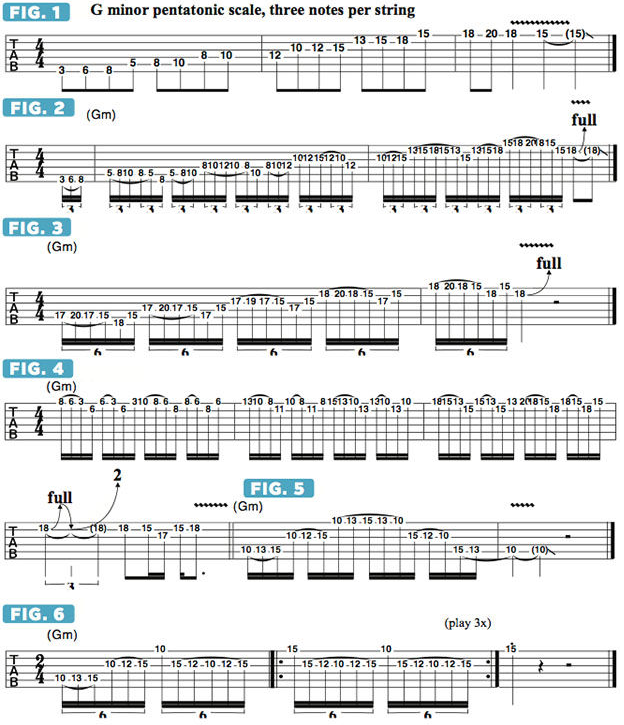Using Monster Three-Notes-Per-String Pentatonic Patterns to Efficiently Traverse the Fretboard
Learn the technically and melodically rewarding three-notes-per-string approach to playing pentatonics in this lesson.
When it comes to soloing using minor pentatonic patterns, most guitarists are well accustomed to using two-notes-per-string “box” positions.
I’d like to show you a three-notes-per-string approach to playing pentatonics and demonstrate a handful of licks that exploit the variety of technical and melodic possibilities that this approach will afford you.
FIGURE 1 illustrates a three-notes-per-string pattern for the G minor pentatonic scale (G Bb C D F): on the lowest two strings, I use my index finger, ring finger and pinkie to fret the three notes. On the D, G and B strings, I switch to index, middle and pinkie, and then on the high E string I revert back to index, ring and pinkie.
When playing this way, I like to keep my fret-hand fingers “standing tall,” so to speak, positioned so that the fingertip is coming straight down onto the string from above. You’ll find that the stretch between the ring finger and pinkie will take some getting used to, as a slight rotation of the fret hand is necessary to reach all the notes comfortably.
FIGURE 2 illustrates the first of five licks I’ve devised using this three-notes-per-string approach: I begin by hammering on from the low G note to Bb and C, and then, after picking D, fifth string, fifth fret, I hammer up to F and G and then pull-off back to F and D, ending the first part of the phrase on C, sixth string, eighth fret. Using hammer-ons and pull-offs in this way creates what is known as a legato (smooth and connected) sound. The nine-note pattern is played in a rhythm of 16th-note triplets.
The idea is then repeated on the A string, starting with the index finger on D, fifth fret, followed by hammer-ons up to F and G and then hammers and pulls on the D string between the notes Bb, C and D. We then continue the pattern moving to each higher string, beginning each new nine-note “shape” by fretting with the index finger.
Now let’s apply this same approach to different starting points on the fretboard. In FIGURE 3, I begin by fretting a D note on the A string’s 17th fret with my middle finger, after which I hammer-on with the pinkie up to F and then pull-off back to D and C, followed by Bb on the low E string and then C on the A string. This shape is then moved up one string, starting on G, D string, 17th fret, and repeated, and then applied to each higher string.
All the latest guitar news, interviews, lessons, reviews, deals and more, direct to your inbox!
Another cool way to apply this concept is to remain on a single pair of strings while steadily climbing the fretboard, as shown in FIGURE 4: I begin this phrase using my index ring, ring finger and pinkie but switch immediately to index, middle and pinkie for the next two positions. FIGURES 5 and 6 offer two examples of incorporating string-skipping techniques into this approach: in both examples, the patterns fall on the A, G and high E strings only.
These phrases are technically challenging and will require diligent practice and limberness to master, so take your time with each shape and strive for clarity and precise execution throughout.

